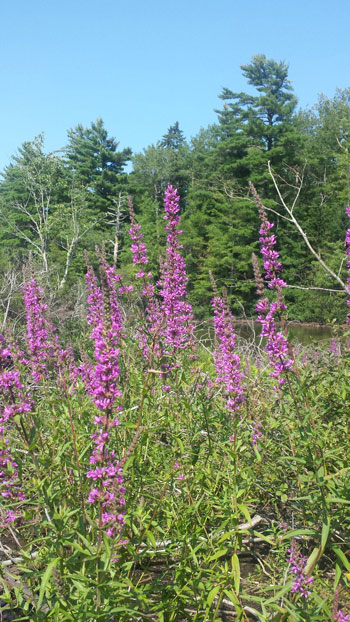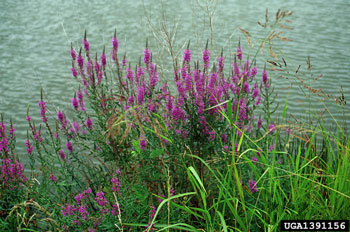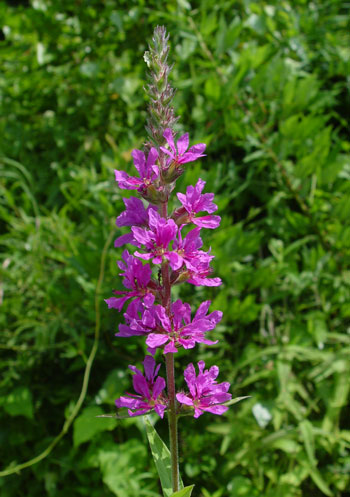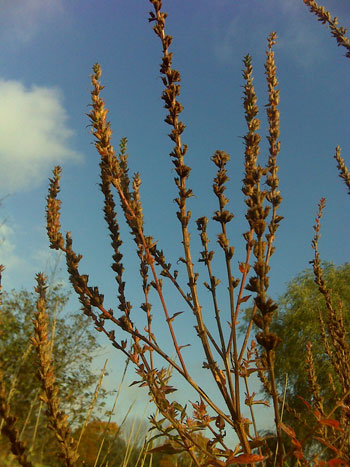DACF Home → Bureaus & Programs → Maine Natural Areas Program → Communities, Plants, and Animals → Invasive Plants → Purple Loosestrife
 Purple loosestrife
Purple loosestrife
Purple Loosestrife
Lythrum salicaria
2019 Status in Maine: Widespread. Very Invasive.
Description: Robust, perennial herb, 4-6', base of mature plant feels woody. Leaves: Simple, opposite or whorled, lanceolate to oblong, entire, sessile. Flowers: In long, crowded spikes, deep pink-purple, 5-7 petals, ½-¾" wide, mid-late summer in Maine. Asynchronous flowering - bottom of spikes open first. Fruit: Brown, dry capsules persisting on stem. Stem: Four-angled.
Native range: Europe and Asia. How arrived in U.S.: As an ornamental, and as contaminant in ballast, livestock bedding, and possibly wool.
Reproduction: By seeds, which are viable for several years. Seeds are readily transported by water and can float for up to three days, or they may hitchhike on wildlife or in soil or fill.
Habitat: Wetlands, rivershores, lakeshores, and wet open areas such as roadsides, agricultural swales, and powerline corridors. Tolerates saturated conditions (organic/peat) and damp mineral soils. Most prolific in full sun, will survive in partial shade.
Similar native species: Fireweed (Chamerion angustifolium) also has spikes of pink-purple flowers, but flowers are large (~1") and 4-petaled. Fireweed has alternate leaves and tends to grow in uplands. Blue vervain (Verbena hastata) has spikes of blue-purple flowers and opposite leaves, but leaves are toothed and the flowers are very small (<1⁄3") and consistently have 5 petals.
Similar non-native species: None in our area.
Fact Sheets and Identification Links
- Vermont Fact Sheet for Purple Loosestrife
- Tip of the Mitt Watershed Council, Minnesota, Identification Video (4:29)
- Purple Loosestrife: What You Should Know, What You Can Do - 4 MB pdf
- Go Botany page for Lythrum salicaria
Control Methods
Small plants or isolated individuals may be dug up by the roots when soil is moist, but re-sprouting may occur.* Persistent cutting or pulling multiple times during the growing season over several years (before flowering) may kill the plant, but diligence is required (at least 3x/yr for 3 yrs is recommended). Herbicides† are effective as foliar applications (aquatic glyphosate solution) or cut-drip applications (aquatic glyphosate applied immediately after cutting). Foliar applications of aquatic triclopyr can control loosestrife while avoiding harm to grasses and sedges. Cut-drip applications report less success than foliar applications and are extremely tedious and time-consuming. Regardless of the method chosen, cutting and bagging any flower heads is suggested since this is a prolific seed producer. Special rules apply to herbicide use in or near wetlands and water bodies - consult the Maine Board of Pesticides Control.
 Purple loosestrife. John D. Byrd, Mississippi State University, Bugwood.org
Purple loosestrife. John D. Byrd, Mississippi State University, Bugwood.org
Control Technique Video Demonstrations
- No appropriate videos found
Please email invasives.mnap@maine.gov if you have questions about invasive species in Maine
 Purple loosestrife flowers
Purple loosestrife flowers
 Purple loosestrife dried inflorescence
Purple loosestrife dried inflorescence